belt OLDSMOBILE SILHOUETTE 1998 Owner's Guide
[x] Cancel search | Manufacturer: OLDSMOBILE, Model Year: 1998, Model line: SILHOUETTE, Model: OLDSMOBILE SILHOUETTE 1998Pages: 444, PDF Size: 23.2 MB
Page 64 of 444
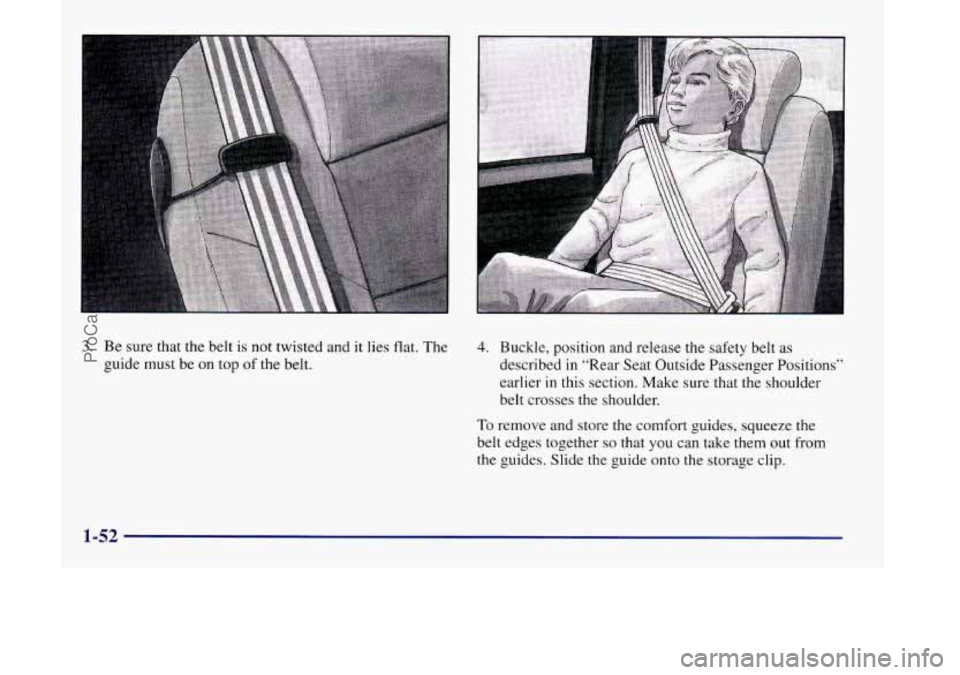
3. Be sure that the belt is not twisted and it lies flat. The 4. Buckle, position and release the safety belt as
guide must be
on top of the belt. described in “Rear Seat Outside Passenger Positions”
earlier
in this section. Make sure that the shoulder
belt crosses the shoulder.
To remove and store the comfort guides, squeeze the
belt edges together
so that you can take them out from
the guides. Slide the guide onto the storage clip.
1-52
ProCarManuals.com
Page 65 of 444
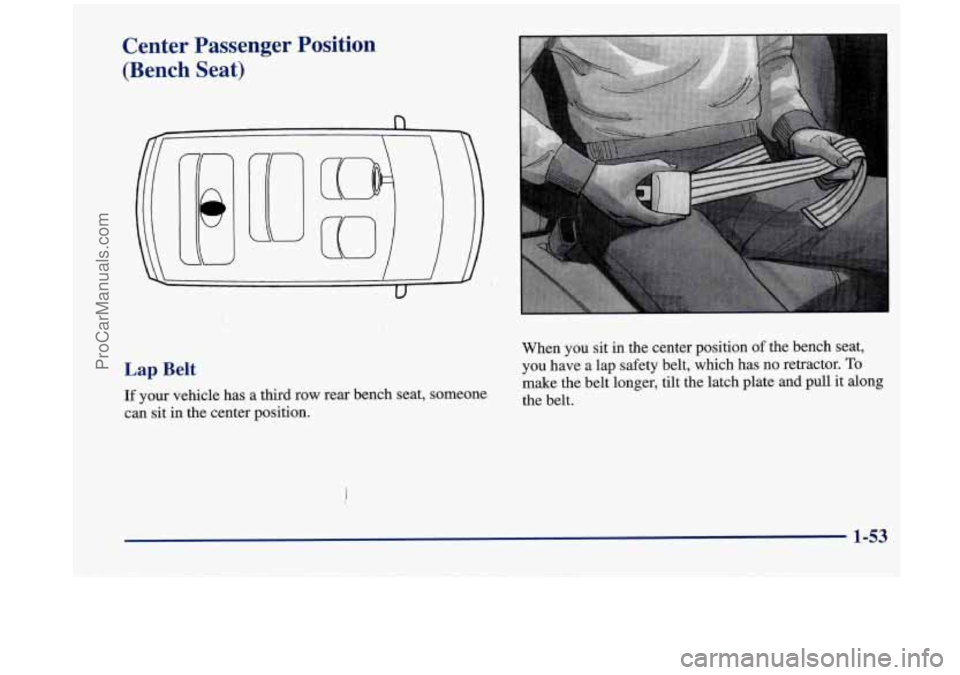
Center Passenger Position
(Bench Seat)
n
Lap Belt
If your vehicle has a third row rear bench seat, someone
can sit in the center position. When
you sit
in the center position of the bench seat,
you have a lap safety belt, which has no retractor. To
make the belt longer, tilt the latch plate and pull it along
the belt.
1-53
ProCarManuals.com
Page 66 of 444
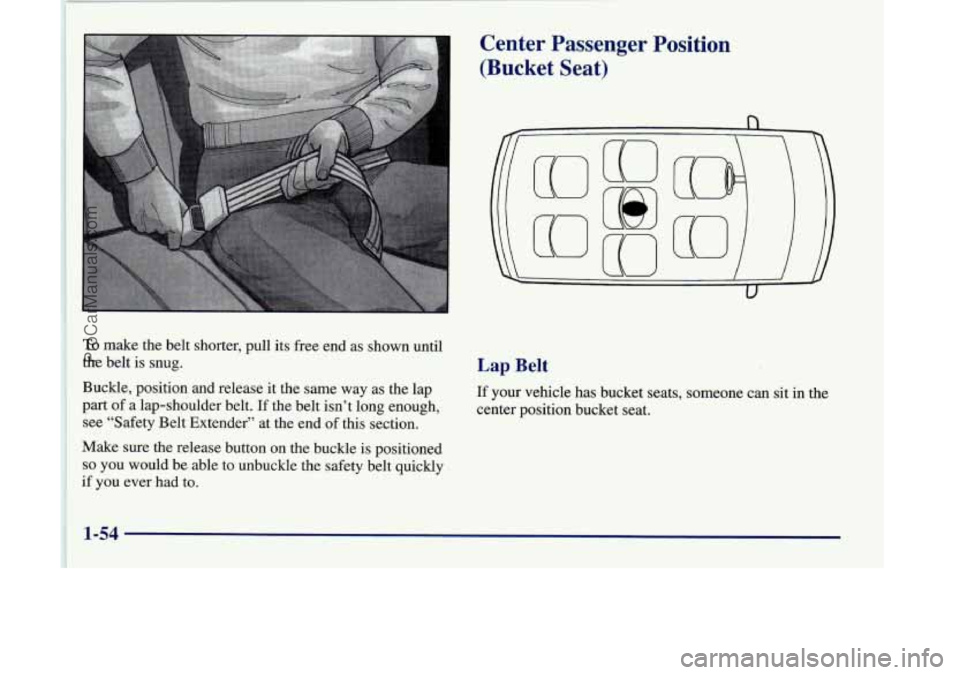
TO make the belt shorter, pull its free end as shown until
the belt is snug.
Buckle, position and release it the same way as the lap
part of a lap-shoulder belt.
If the belt isn’t long enough, ~
~ see “Safety Belt Extender” at the end of this section.
Make sure the release button on the buckle
is positioned
so you would be able to unbuckle the safety belt quickly
1 if you ever had to.
Center Passenger Position
(Bucket Seat)
n
U
Lap Belt
If your vehicle has bucket seats, someone can sit in the
center position bucket seat.
1-54
ProCarManuals.com
Page 67 of 444

When you sit in the center position bucket seat, you
have a lap safety belt which has
a retractor.
1. Pick up the latch plate and, in a single motion, pull
the belt across you. Don’t let it get twisted.
2. Push the latch plate into the buckle until it clicks. If
the belt stops before it reaches the buckle, let it go
back
all the way and start again. Pull up on the latch
plate to make sure
it is secure.
3. Feed the lap belt into the retractor to tighten it.
4. Position and release it the same way as the lap part
of a lap-shoulder belt.
If the belt isn’t long enough, see “Safety Belt
Extender” at the end of this section. Make sure the
release button on the buckle is positioned
so you
would be able to unbu&le the safety belt quickly
if
you ever had to.
1-55
ProCarManuals.com
Page 68 of 444
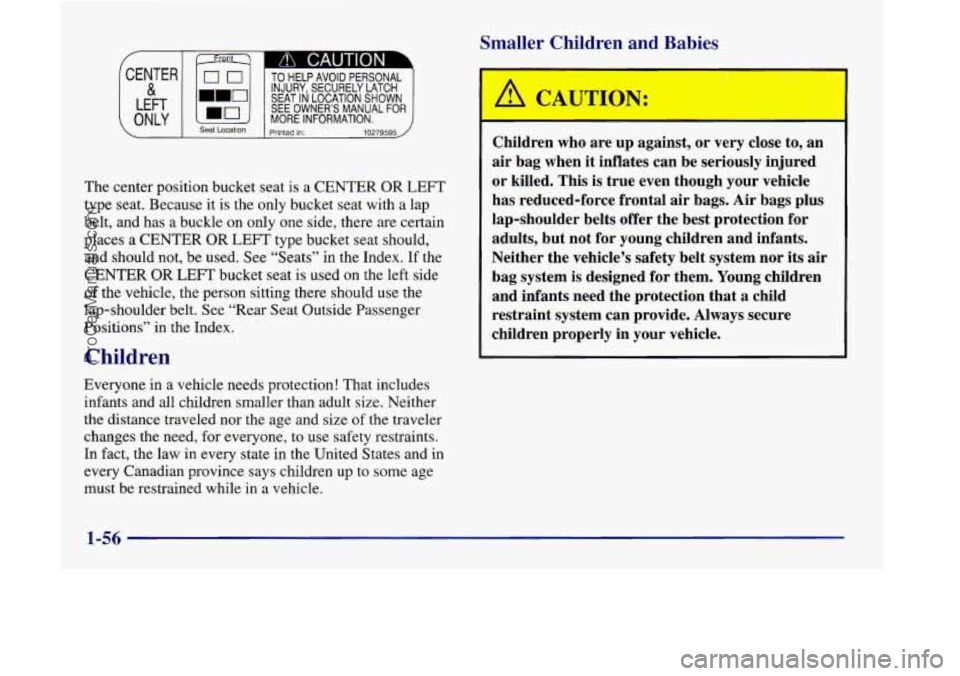
Smaller Children and Babies
c A CAUTION
TO HELP AVOID PERSONAL
SEAT IN LOCATION SHOWN
INJURY, SECURELY LATCH
SEE OWNER’S MANUAL
MORE INFORMATION. ONLY _. Seat Location printed in: 10279595
The center position bucket seat is a CENTER OR LEFT
type seat. Because it is the only bucket seat with a lap
belt, and has a buckle on only one side, there are certain
places a CENTER
OR LEFT type bucket seat should,
and should
not, be used. See “Seats” in the Index. If the
CENTER OR LEFT bucket seat
is used on the left side
of the vehicle, the person sitting there should use the
lap-shoulder belt.
See “Rear Seat Outside Passenger
Positions” in the Index.
Children
Children who are up against, or very close to, an
air bag when it inflates can be seriously injured
or killed. This is true even though your vehicle
has reduced-force frontal air bags.
Air bags plus
lap-shoulder belts offer the best protection for
adults, but not for young children and infants.
Neither the vehicle’s safety belt system nor its air
bag system is designed for them. Young children
and infants need the protection that
a child
restraint system can provide. Always secure
children properly in your vehicle.
Everyone in a vehicle needs protection! That includes
infants and all children smaller than adult size. Neither
the distance traveled nor the age and size
of the traveler
changes the need, for everyone, to use safety restraints.
In fact, the law in every state in the United States and
in
every Canadian province says children up to some age
must be restrained while in a vehicle.
1-56
ProCarManuals.com
Page 69 of 444
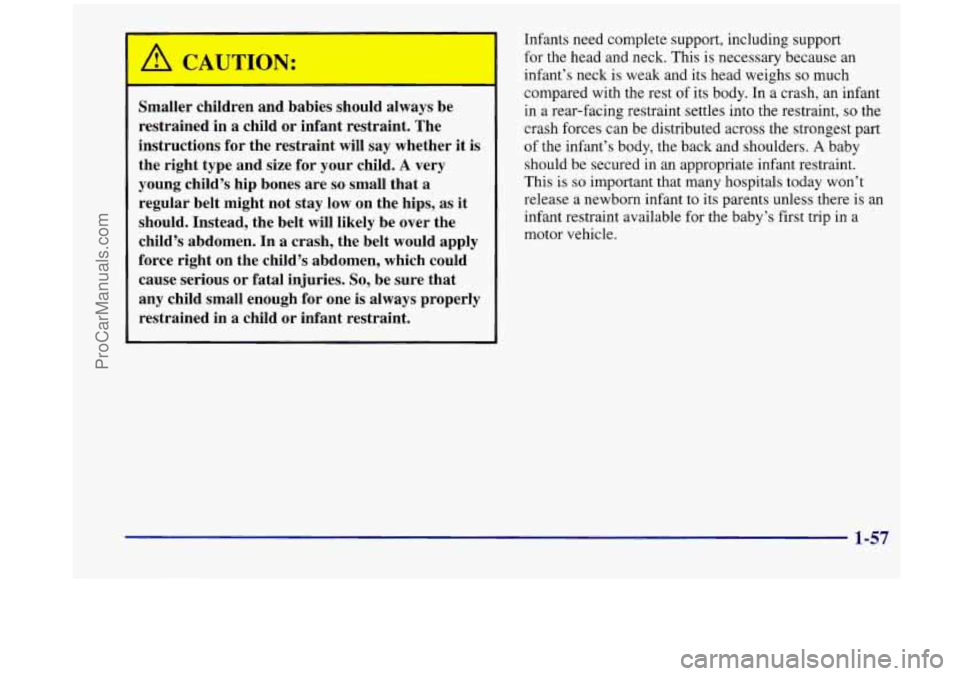
Smaller children and babies should always be
restrained in a child or infant restraint. The
instructions
for the restraint will say whether it is
the right type and size for your child. A very
young child’s hip bones are
so small that a
regular belt might not stay low on the hips, as it
should. Instead, the belt will likely be over the
child’s abdomen. In a crash, the belt would apply
force right on the child’s abdomen, which could
cause serious or
fatal injuries. So, be sure that
any child small enough for one is always properly
restrained in a child or infant restraint.
Infants need complete support, including support
for the head and neck. This is necessary because an
infant’s neck is weak and its head weighs
so much
compared with the rest of its body. In a crash, an infant
in a rear-facing restraint settles into the restraint,
so the
crash forces can be distributed across the strongest part
of the infant’s body, the back and shoulders. A baby
should be secured in an appropriate infant restraint.
This is
so important that many hospitals today won’t
release a newborn infant to its parents unless there is an
infant restraint available for the baby’s first trip in a
motor vehicle.
1-57
ProCarManuals.com
Page 72 of 444
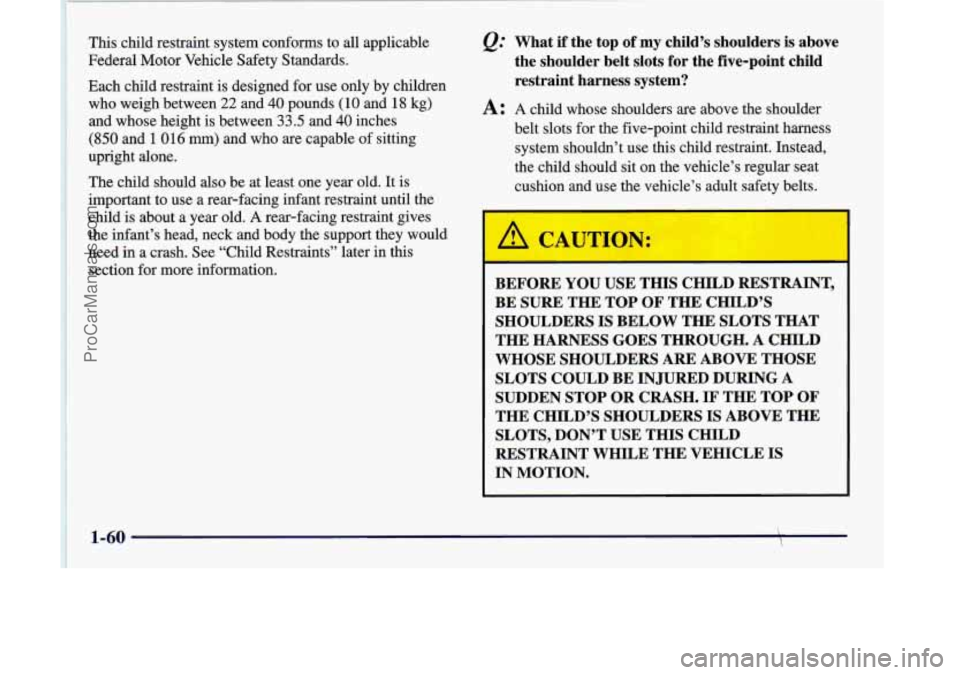
This child restraint system conforms to all applicable
Federal Motor Vehicle Safety Standards.
Each child restraint is designed for use only by children
who weigh between
22 and 40 pounds (10 and 18 kg)
and whose height is between 33.5 and 40 inches
(850 and 1 016 mm) and who are capable of sitting
upright alone.
The child should
also be at least one year old. It is
important to use a rear-facing infant restraint until the
child is about a year old.
A rex-facing restraint gives
the infant’s head, neck and body the support they would
need in a crash. See “Child Restraints” later in this
section for more information.
&: What if the top of my child’s shoulders is above
the shoulder belt slots for the five-point child
restraint harness system?
A: A child whose shoulders are above the shoulder
belt slots for the five-point child restraint harness
system shouldn’t use
this child restraint. Instead,
the child should sit
on the vehicle’s regular seat
cushion and use the vehicle’s adult safety belts.
BEFORE YOU USE THIS CHILD RESTRAINT,
BE SURE THE TOP
OF THE CHILD’S
SHOULDERS
IS BELOW THE SLOTS THAT
THE HARNESS GOES THROUGH.
A CHILD
WHOSE SHOULDERS ARE ABOVE THOSE
SLOTS COULD BE INJURED DURING
A
SUDDEN STOP OR CRASH. IF THE TOP OF
THE CHILD’S SHOULDERS IS ABOVE THE
SLOTS, DON’T USE
THIS CHILD
RESTRAINT WHILE THE VEHICLE
IS
IN MOTION.
1-60
ProCarManuals.com
Page 74 of 444

3. Lower the child restraint cushion. You’ll be using the child restraint’s harness (A) to
secure your child. Don’t
use the vehicle’s
safety belts.
1-62
ProCarManuals.com
Page 75 of 444

Using the vehicle’s regular safety belts on a child
seated on the child restraint cushion can cause
serious injury to the child in a sudden stop or
crash.
If a child is the proper size for the built-in
child restraint, secure the child using the child
restraint’s harness. But children who are too
large for the built-in child restraint should sit on
the vehicle’s regular seat and use the vehicle’s
adult safety belts.
WARNING! FAILURE TO FOLLOW THE
MANUFACTURER’S INSTRUCTIONS ON THE
USE
OF THIS CHILD RESTRAINT SYSTEM
CAN RESULT IN YOUR CHILD STRIKING THE
VEHICLE’S INTERIOR DURING A SUDDEN
STOP OR CRASH. SNUGLY ADJUST THE
BELTS PROVIDED WITH THIS CHILD
RESTRAINT
AROUND YOUR CHILD.
4. Before placing the child in the child restraint, add
slack to the shoulder harness. Pull the black shoulder
harness release strap
firmly. At the same time pull
both shoulder harness straps through the slots in the
seatback as shown.
5. Place the child on the child restraint cushion.
1-63
ProCarManuals.com
Page 86 of 444
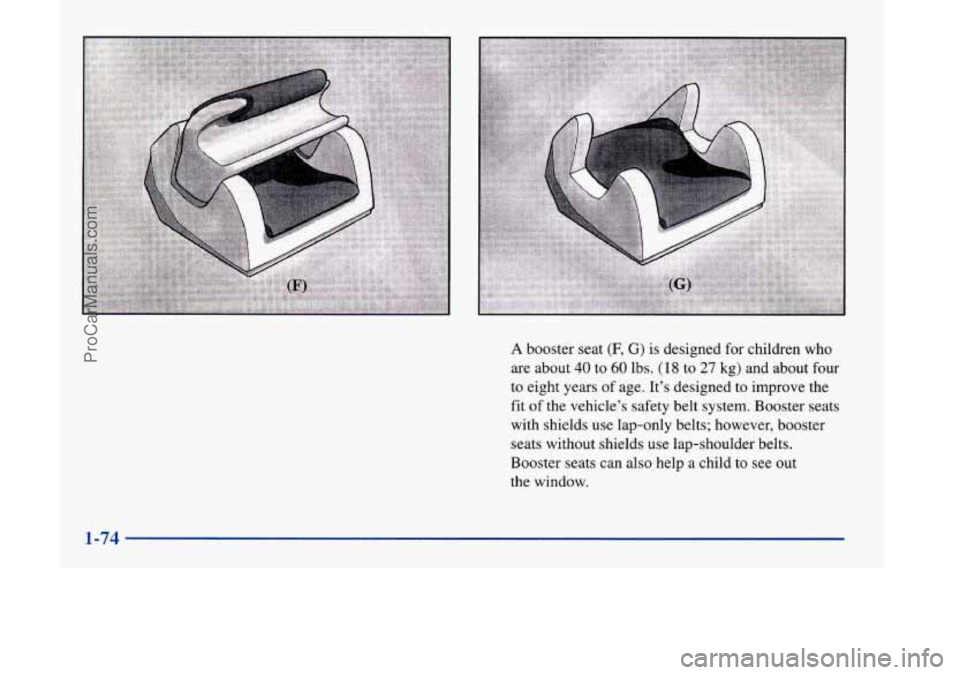
A booster seat (F, G) is designed for children who
are about
40 to 60 lbs. (18 to 27 kg) and about four
to eight years of age. It’s designed to improve the
fit of the vehicle’s safety belt system. Booster seats
with shields use lap-only belts; however, booster
seats without shields use lap-shoulder belts.
Booster seats can also help a child to see out
the window.
1-74
ProCarManuals.com